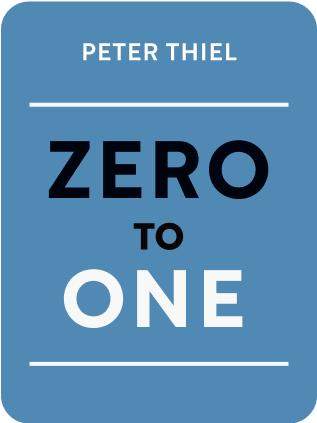

This article is an excerpt from the Shortform summary of "Zero To One" by Peter Thiel. Shortform has the world's best summaries of books you should be reading.
Like this article? Sign up for a free trial here .
Are you looking for a guide for startups? Do you want to build a startup that’s sure to succeed?
This guide for startups can help you begin your startup journey. From thinking like a founder to how to create company culture, this guide for startups has all the basics to launch your company research.
Your Guide for Startups
This guide for startups has two main sections. One contains the basics for building your team and thinking like a startup, and the other is about building a monopoly. While turning your startup into a monopoly might not be in the forefront of your mind when building your startup, you should be thinking like a monopoly.
Startup Thinking
For several reasons, startups consisting of a few people with a mission are the source of most new technology.
Big organizations don’t often produce new technology because they tend to avoid risk. People working alone seldom produce new technology either. A brilliant loner might produce great art, but she wouldn’t have the means to create a new industry.
Startups work because it takes multiple people to create new technology, but also smallness for momentum and flexibility. Small companies encourage and are conducive to new thinking because they know new thinking is their biggest asset.
This book explores the questions that companies creating new things must answer in order to succeed. It’s a starting point rather than a manual. The first job of a startup is to question everything and rethink business from the beginning.
Your Guide for Startups: The Basics
When starting a company, it’s important to choose leaders who have the right technical knowledge and whose skills are complementary. Equally important, however, is how well the founders know each other and work together. You also need a structure and clearly defined roles so everyone is aligned to move the organization forward. Having the right guide for startups makes a huge difference.
For effective alignment, you must make three decisions:
- Ownership: Who will own the company’s equity. Ownership is typically divided among founders, employees, and investors.
- Possession: Who will run the company day-to-day. It may be a founder/CEO or manager and employees.
- Control: Who will govern the company. A board of directors (usually consisting of founders and investors) maintains control.
Compensation
A CEO of a venture-funded startup shouldn’t be paid more than $150,000 a year. High pay (more than $300,000) encourages him to protect his salary by defending the status quo and minimizing problems rather than exposing and fixing them.
Other advantages of low CEO pay are that it:
- Encourages the executive to focus on increasing the value of the company.
- Motivates employees to work harder. By working for lower pay, an executive demonstrates his commitment to the company and its mission. Employees will follow his example.
By the same token, over-paying employees encourages them to focus on what the company is doing in the present instead of thinking about how to increase the company’s value in the future. Cash bonuses also encourage short-term thinking. Offering equity or part ownership of the company shifts the focus to the future.
Recruiting
The first few employees in a startup might be attracted by exciting roles or equity. But beyond your first round of hires, you must be able to articulate to the 20th candidate why she should want to join your company.
Your answers need to be specific to your company. They should address:
1) Your mission: Explain what makes your mission unique and compelling—what’s the important thing you’re doing that no one else is doing?
2) Your team: Show potential employees that the people on your team are the kind of people they want to work with. Show recruits how your company is a unique match for them.
Don’t cite your perks—you don’t want people working for you who can be convinced to do so by things like laundry pickup because that’s an indication of superficiality. Your unique mission is what should count.
Guide for Startups: Building a Monopoly
Also critical to a monopoly startup’s success is how you choose and expand your market. Start with a small market because it will be easier to dominate than a large one. A guide for startups typically won’t cover what it takes to build a monopoly—or why you should be thinking about it when you plan.
But make sure that your intended market really exists. PayPal’s first market—PalmPilot users who wanted to send money to each other—was essentially nonexistent. PalmPilot users were scattered around the world and had little in common, so not many of them needed to send money to each other.
After dropping that idea, PayPal targeted eBay auctions and found success by serving 25% of a few thousand high-volume power sellers who really needed a way to receive payments online. It’s better to focus on a small number of customers involved in a common activity or concentrated in a particular environment with no competitors than to reach for millions of disparate users.
Sometimes entrepreneurs think they’ll profit by getting a small share of a huge market—for instance, 1% of a $100 billion market. But even if you get a foothold in the market, as a small player, you won’t make money because competition will eat up your profits.
Expanding
Once you’ve dominated a small market, slowly expand into related markets that are a bit wider.
This was Amazon’s approach. Jeff Bezos’s long-term goal was to dominate online retail, but he chose to start by selling only one thing—books. Amazon quickly became the dominant source of books for people who didn’t live near a bookstore or who wanted books not available in their area.
After a successful start with books, Amazon’s options for scaling up were to either increase the number of book customers (readers) or expand into similar markets. The company began selling CDs, videos, and software and gradually expanded to other categories until it became the dominant online retailer.
eBay also started small, focusing first on Beanie Baby collectors, then moved on to other collectors and hobbyists before ultimately becoming the top auction marketplace for selling something online. However, eBay learned there are limits to scale. It found that the auction model worked better for selling distinctive products like coins and stamps than for commodity items like pencils, which were easier to buy on Amazon than to bid for on eBay. eBay is still a successful monopoly, although smaller than originally envisioned.
Don’t Be a Disrupter
“Disruption” continues to be a buzzword in Silicon Valley, but for startups, the concept can limit or distort your thinking and thus undermine success. This guide for startups is unique in that it says don’t be a disruptor.
Originally, disruption meant the strategy of using new technology to make and sell a product cheaply, then gradually improve it and surpass high-end versions sold by competitors using older technology. PCs disrupted the market for mainframe computers; at first they seemed insignificant, but they eventually displaced mainframes. Similarly, mobile devices are disrupting the market for PCs.
However, the term disruption has since come to mean little more than changing or improving something. When entrepreneurs think of their companies as disrupting a market, they’re focusing on things as they currently are, rather than coming from a new perspective. It’s far more important to focus on the new product you’re creating than on how old companies will react to it. If your company is fixated on disrupting existing companies, then it isn’t entirely new and isn’t likely to become a monopoly.
Disruptive companies also get into losing battles. For example, in 1999, Napster tried to disrupt the music recording industry but ultimately ended up in bankruptcy.
While some might view PayPal as disruptive, it didn’t challenge an existing company. PayPal took some business from Visa initially, but it actually ended up helping Visa by expanding the market for online payments overall. PayPal created a positive dynamic, while Napster aimed to eliminate an industry.
As you expand your startup into related markets, don’t try to be a disrupter. Instead, avoid competitive markets.
Be a ‘Last Mover’
The “first mover advantage” means getting into a new market first and gaining a substantial share of the market before anyone else gets there.
But moving first is a tactic, not a goal.” Your goal is to generate cash flows for the future. You do this by starting with a small slice of the market (being the first mover) and gradually expanding, dominating each new slice until you own the ultimate market for your product. You want to be the last mover—the one who makes the last spectacular improvement in a market that ensures years of monopoly profits.
Being a first mover puts you in position to be the last mover.
This guide for startups can serve as a launching point for your company. There’s a lot to consider before starting a new company, and this guide for startups offers a good way to begin.

———End of Preview———
Like what you just read? Read the rest of the world's best summary of Peter Thiel's "Zero To One" at Shortform .
Here's what you'll find in our full Zero To One summary :
- Why some companies genuinely move the world forward when most don't
- How to build a company that becomes a monopoly (and why monopolies aren't bad)
- Silicon Valley secrets to selling products and building rockstar teams






